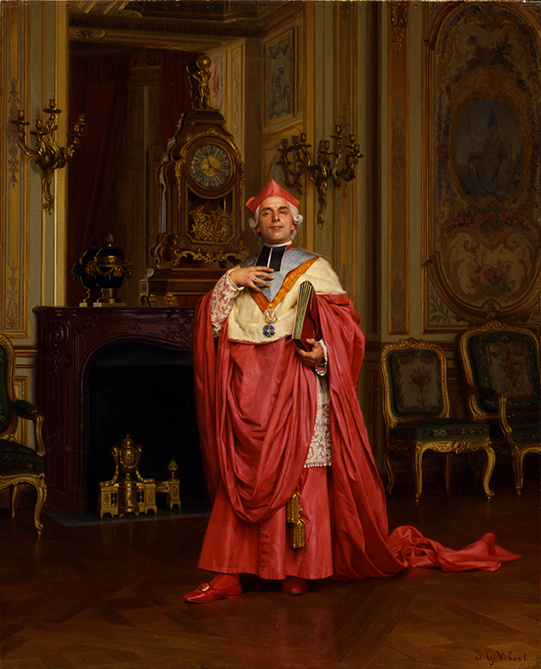
In The Red Portfolio, Jehan-Georges Vibert pokes fun at his favorite victim, a cardinal. The main point of this painting is the immense pride of an unidentified but elegant cardinal standing self-consciously in the council chamber of Louis VX at Fontainebleau. His air of self-importance, as he strikes a pose before an elegant fireplace, swelling his chest to better display his royal decorations, implies that he fancies himself a successor to the great cardinal-ministers of France, Richelieu, Mazarin, and Fleury.
Cleary the cardinal’s mind is more occupied with this world than the next. His attire is fashioned of the most expensive materials, ermine, silk, gold, and lace – a match for the elegant Rococo interior. Yet the shadow if a beard – it is already four, according to the clock – implies human fallibility behind the impeccable façade. Even his perfect grooming is slightly flawed by a wig that does not quite cover his dark sideburns.
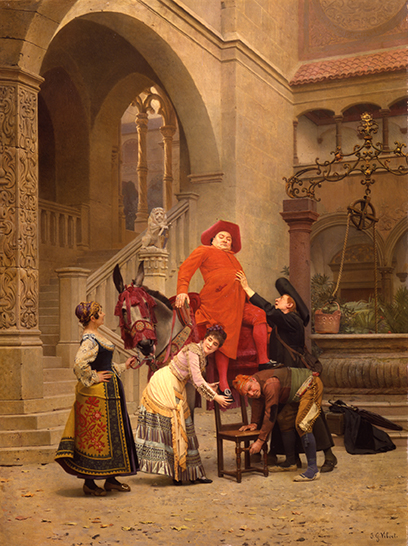
His Eminence Returns is one of Jehan-George’s Vibert’s Spanish subjects lampooning clergymen. He painted many of them in the late 1860s and 1870s. This painting demonstrates Vibert’s knack for theatrical and comic presentation. A cardinal, a favorite target of his wit, is the focal point of the little farce. In this case, Vibert also makes himself the butt of ridicule, since he used his own features and corpulent physique for the cleric.
The dignitary has lost his agility through good living and is perhaps a bit tipsy as well. In any event, dismounting is a major operation, involving the help of an anxious abbe, a servant who stoops to provide footing, an attendant to balance his right foot, and another to steady the mule. Vibert heightens the humor by showing the strain of the bent-over man and the protruding tongue of the animal; both will be happy when relieved of their burden. The two women seem silently amused by the ordeal.

Check, by Jehan-Georges Vibert, depicts an event from the life of Napoleon Bonaparte. Despite his grandfather’s hero-worship of Napoleon, Vibert, the thorough iconoclast, mocks even him. The famous general has just been placed in check – perhaps both literally and figuratively – by his wily uncle, Cardinal Joseph Fesch (1763-1839). Fesch, who owed his high ecclesiastical position as well as his magnificent art collection to his nephew, smugly takes a pinch of snuff. Vibert may have caught a cardinal meddling in politics.
As usual, Vibert is concerned with the accuracy of historical details. He obviously studied portraits of both characters and reproduced their costumes precisely, down to the Legion of Honor medals they wear. He has reproduced Napoleon’s bedroom at the palace of Fontianebleau, including the Emperor’s own self-adulating symbols – the initial “N,” the Bonaparte bees, laurel wreaths, and olive branched. Perhaps Vibert meant to allude to the vanity of power as much as to the meddling of the church in political affairs.
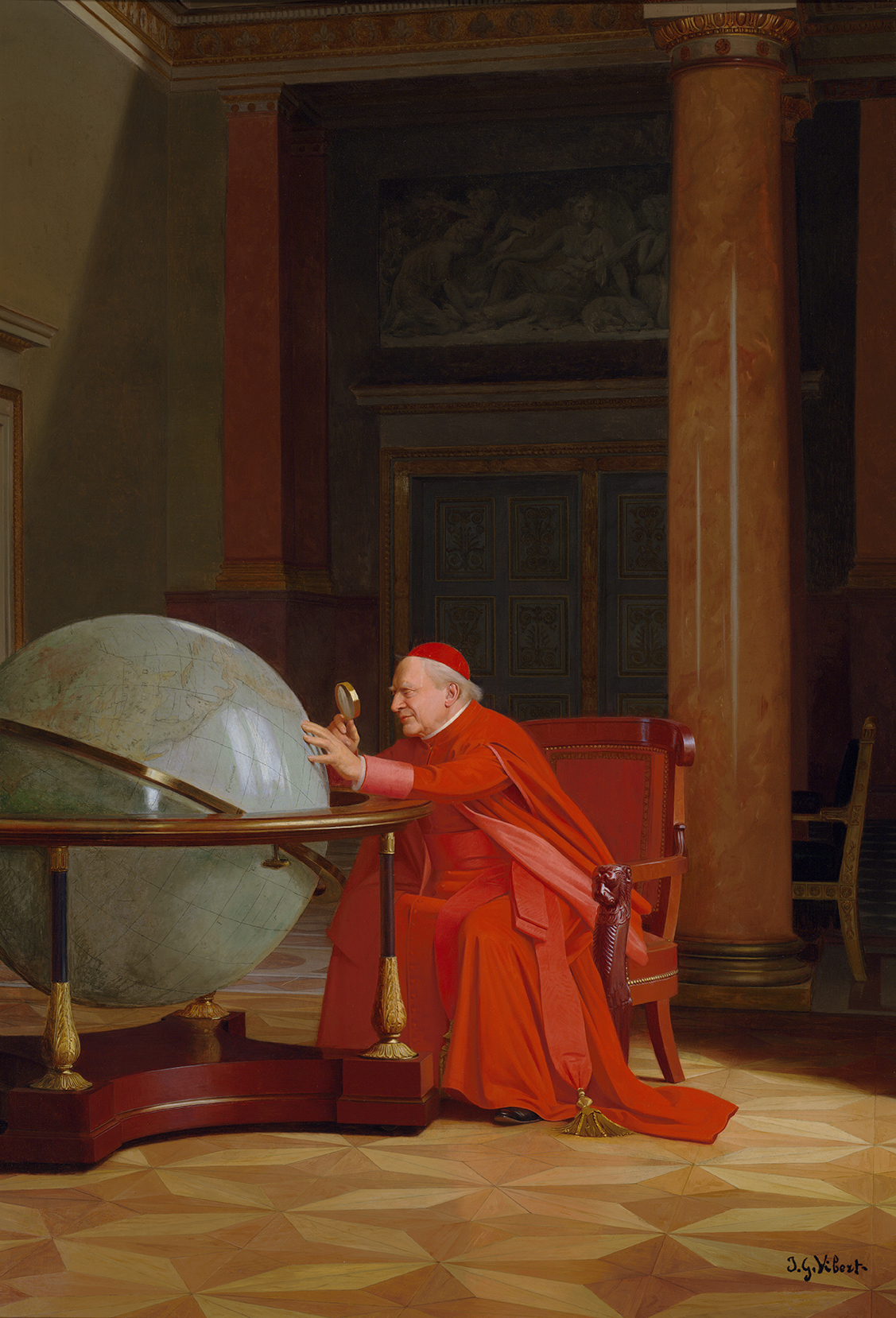
A Roman Catholic Cardinal, robed in Vibert’s red (a blend of pigments which created a vibrant red that is known as Vibert’s red), sits bathed in light before a large globe. He holds a magnifying glass in his right hand and appears to be gently touching the globe with his left hand. The Cardinal’s attention is focused on South America. The room in which he sits is elegantly decorated with marble columns and parquet wood floors, which illustrates the opulence and sophistication of France and the Roman Catholic Church.
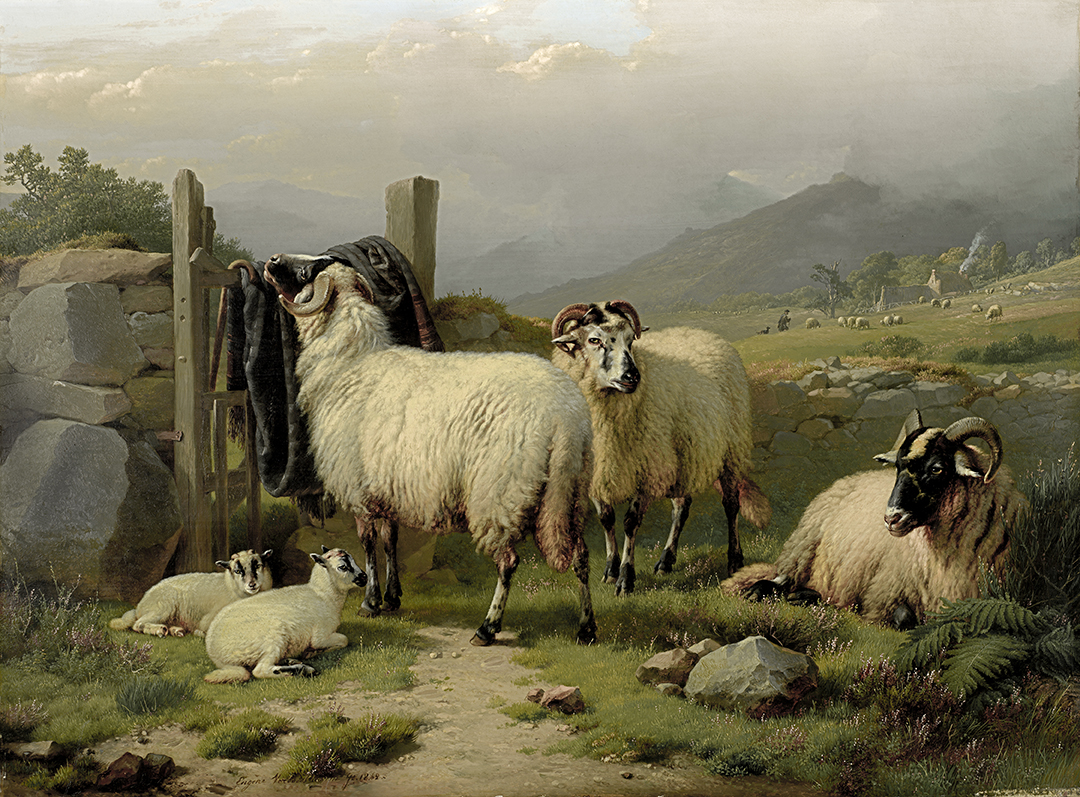
Highland Monarch is one of the many representations of animals in the Scottish Highland that Eugene-Joseph Verboeckhoven produced in the 1860s and 1870s. The sheep, with their black-and-white mottled faces, curved horns, and bulky coats are typical of a Highland variety still commonly seen today. The mountainous landscape and cottages in the background create an appropriate setting. While difficult to make out because of his small size, the shepherd in the distant meadow appears to wear traditional Scottish garb.
Verboeckhoven’s high standards of craftsmanship meant attention to detail, care in composition, and careful execution. It is evident that the artist worked out the composition with an eye to balance before he touched brush to canvas. The sheep pose on converging diagonals that span the picture plane. The eye is taken back from the immediate foreground, along the stone wall of the enclosure to the lit meadow to the distant peaks obscured by clouds. Such careful planning establishes an overall harmony that is reinforced by gentle colors.
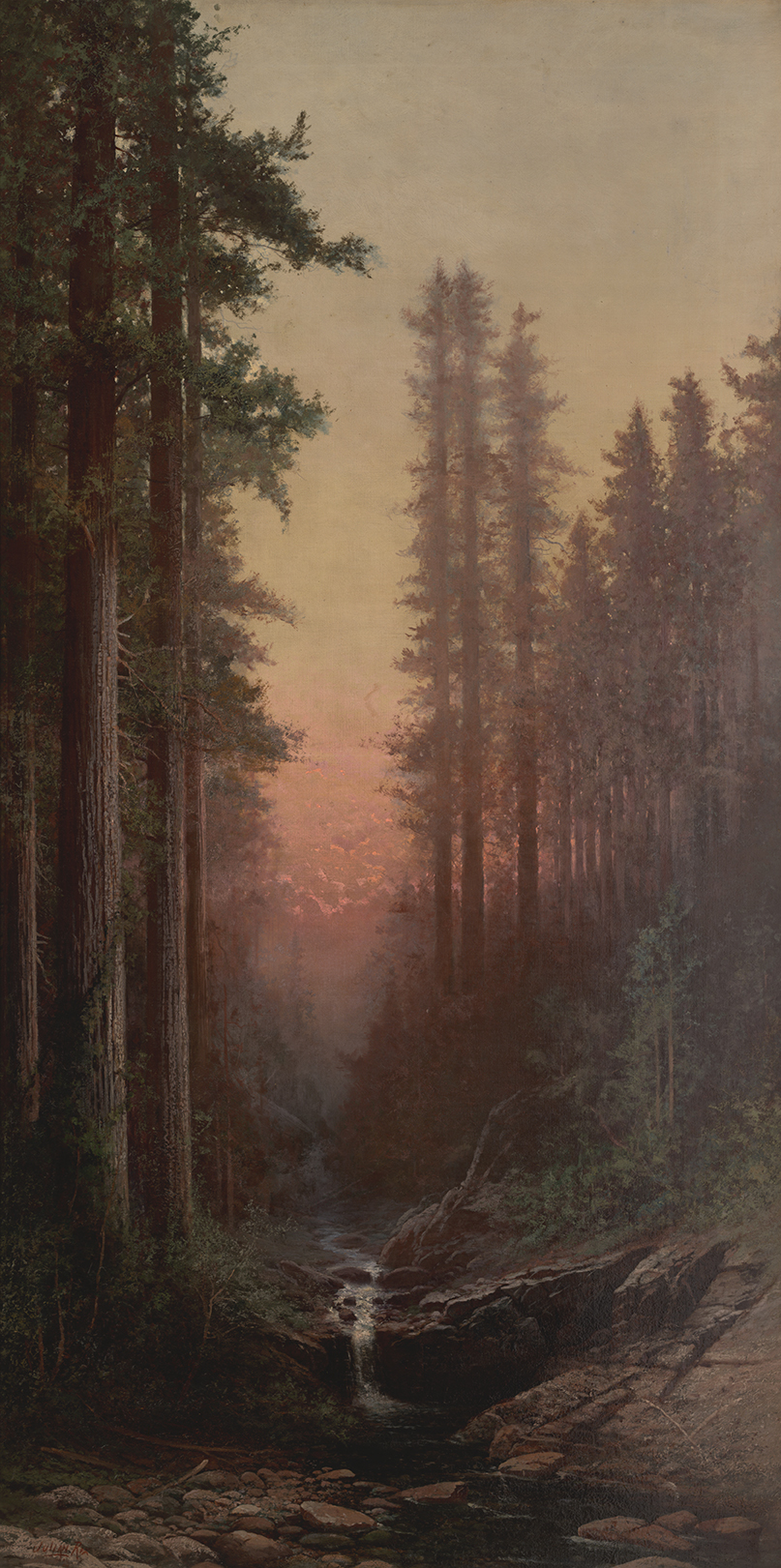
Julian Rix was known for his atmospheric paintings and his use of light. His work was reminiscent of the Barbizon school; however, he had his own style that included palette knife strokes and the use of pure pigments that produced stronger colors. Rix frequently painted both in his studio and outdoors. Redwoods showcases Rix’s ability to use brushstrokes to move the viewer’s gaze around the painting.

La Toilette, by Pierre-Auguste Renoir, captures an intimate moment between two ladies of leisure. One woman is gracefully seated in a velvet chair—a Victorian chaise lounge spotted in the background—as the other woman stands, gingerly affixing an ornament to the seated woman’s hair. The colors are warm and pleasing shades of peach, apricot, pink, and opal to suggest light and movement. Short, broken brushstrokes intersect to compose the bold contours of the female figures and the room décor.
Renoir was among the rebellious painters known as the Impressionists, famed for being shunned by art academies and developing their own vibrant and provocative techniques to capture scenes of metropolitan life; Renoir was one of the movement’s most popular artists. He was known for his brilliant eye for capturing scenes of domesticity and the day’s fashions. His images of well-dressed, middle-class Parisian families, as seen here, helped to define the modern era of the late nineteenth century in Europe.

This work by Thomas Hill, commonly referred to as Waterfall, emphasizes the height of the trees, the rugged steeps of the mountains, and serene waters cascading into a brook. The man near the center of the painting demonstrates the relative magnitude of nature. The lower forest’s dark shadows draw the eye up to the light at the top of the painting where the viewer sees snowy mountain caps. The sunlight in the center of the painting gives a depth of perception and contrasts the dark forestry. Hill layers green and brown paint strokes in the leaves and over the trees for texture, and he adds delicate hints of white on the flowers to give the appearance of new growth blooming near the water.
Hill became one of California’s most successful landscape artists and was a transitional figure in American landscape painting. He synthesized the influences of the Hudson River and Barbizon Schools of art into a style that was completely his own. He would go on to paint stunning representations of Yellowstone, the Russian River, Lake Tahoe, and most notably the Yosemite Valley.
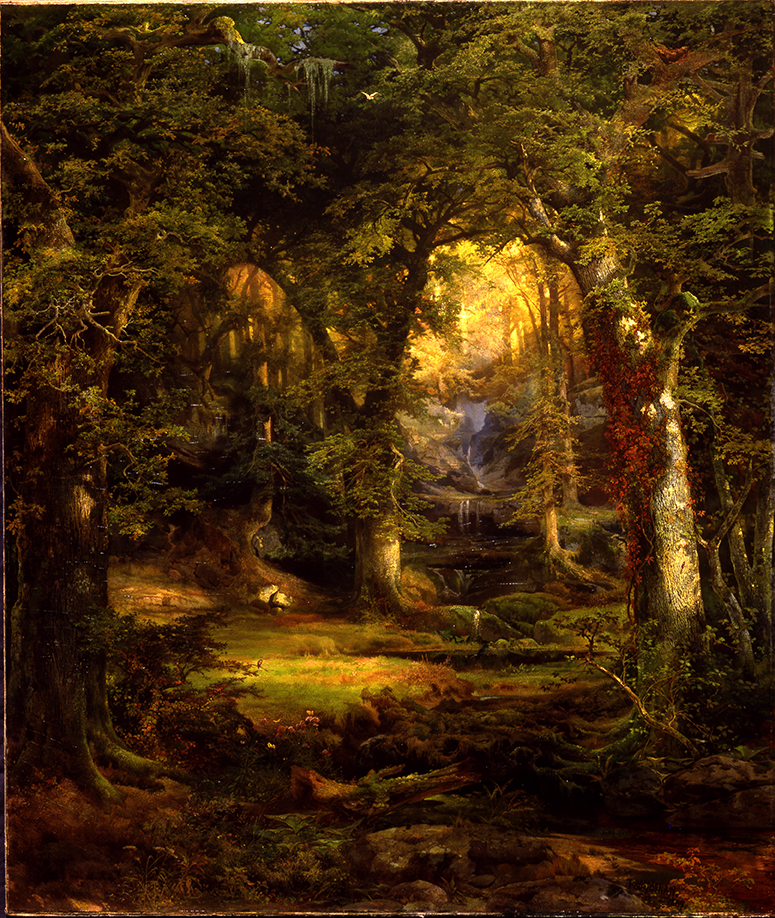
In Woodland Temple, a rich tapestry of observed detail allows the viewer to suspend disbelief in the obviously contrived double arch in the center. Moran filled the foreground with plants, mossy rocks and tree roots, a mushroom-studded log, butterflies, birds, ancient trees with wrinkled bark, exposed roots, and fantastically twisted branches. A bright patch of light between the right-hand arch nearly merges into a cross, which draws the eye upward to a hovering white bird. These details invite a religious interpretation of the scene. Such an implication of the presence of the Divine in nature is, of course, consistent with the Romantic philosophy of the Hudson River School painters, and certainly Moran continues this point of view. This idea, moreover, was strengthen in mid-century by the writings of Ruskin, which were read by Moran and so many other American painters.
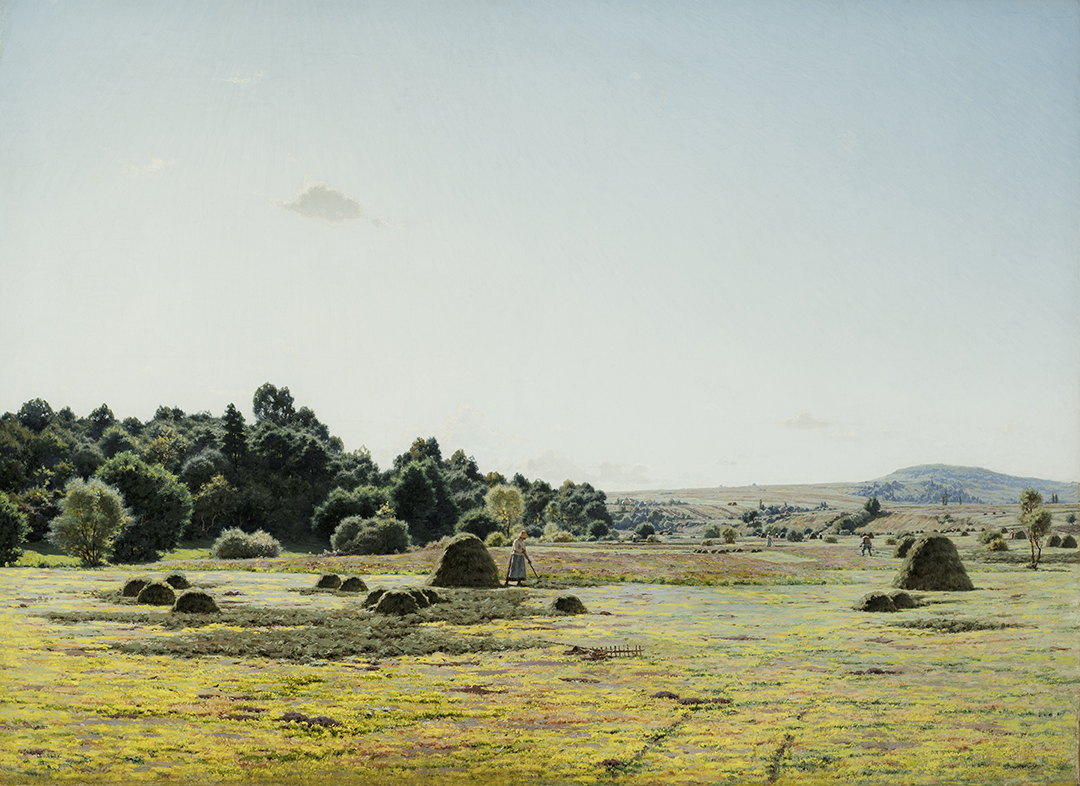
The stark light-dark contrast of The Far Hill gives the impression of luminosity for which Jan Monchablon was best known. The low vantage point puts the viewer on the level of the harvesters. He carefully leads the eye into the distance—along cart tracks and a rake in the immediately foreground, which point to haystacks and a peasant woman working, then to a cluster of trees, and finally to the distant rise of the hill.
His painting technique also helps to imply depth. Thick brushstrokes in the foreground suggest stubble and cut hay, while smooth, thin application makes distant features seem farther away. Likewise, the intensive yellow-greens and oranges of the near view pull forward from the faded pastels farther back. The color changes are explained by a brilliant sun that, judging by the small shadows, is near its zenith. The same sun paled the sky that fills more than half the painting, transforming it into a vast luminous screen.











